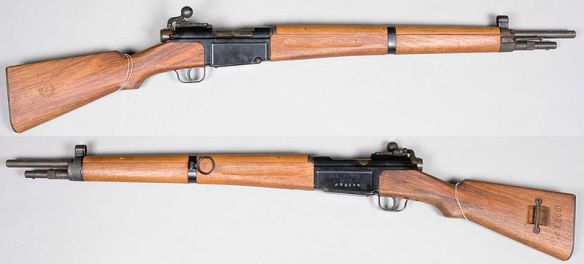
MAS36
In the period following World War I the French army decided to adopt a new standard service cartridge with a calibre of 7.5 mm (0.295 in). The new cartridge was adopted in 1924, but following some low-priority and therefore lengthy trials, it was found that the new cartridge was unsafe under certain circumstances and thus had to be modified in 1929. In that year the French decided to adopt a new rifle to fire the new round, but it was not until 1932 that a prototype was ready. Then followed a series of further trials that went on at a slow pace until 1936, when the new rifle was accepted for service.
The new rifle was the Fusil MAS36 (MAS for Manufacture d’Armes de Saint-Etienne). This used a much modified Mauser action which was so arranged that the bolt handle had to be angled forward quite sharply. The box magazine held only five rounds. The MAS36 had the odd distinction of being the last bolt-action service rifle to be adopted for military service anywhere (all later new weapons using some form of self-loading action) and in some other ways the MAS36 featured other anachronisms. In typical French style the weapon had no safety catch, and the overall appearance of the design belied its year of introduction, for it looked a much older design than it was.
Production of the new rifle was so slow that a modification programme to convert some of the old rifles for the new cartridge had to be undertaken. This lack of urgency was typical of the period for the nation seemed to suffer from an internal lethargy that could be traced back to the nation’s exertions of World War I. Thus by 1939 only a relatively few French army units were equipped with the MAS36, and these were mainly front-line troops. The MAS36 could have had little effect on the events of May and June 1940, but many of the troops who left France at that time took their MAS36s with them and for a while it remained the favoured weapon of the Free French forces in exile. The Germans also took over numbers of MAS36s and used them under the designation Gewehr 242(f) for their own garrison units based in occupied France.
One odd variation of the basic MAS36 was a version known as the MAS36 CR39. This was a short-barrelled version intended for paratroop use, and had an aluminum butt that could swivel forward alongside the butt to save stowage space. Only a relative few were ever made, and even fewer appear to have been issued for service use.
When the war ended the new French army once more took the MAS36 into use and retained it for many years, using it in action in North Africa and Indo-China, Many are still retained for use as ceremonial parade weapons and the type is still used by the forces and police authorities of many colonial or ex-colonial states.